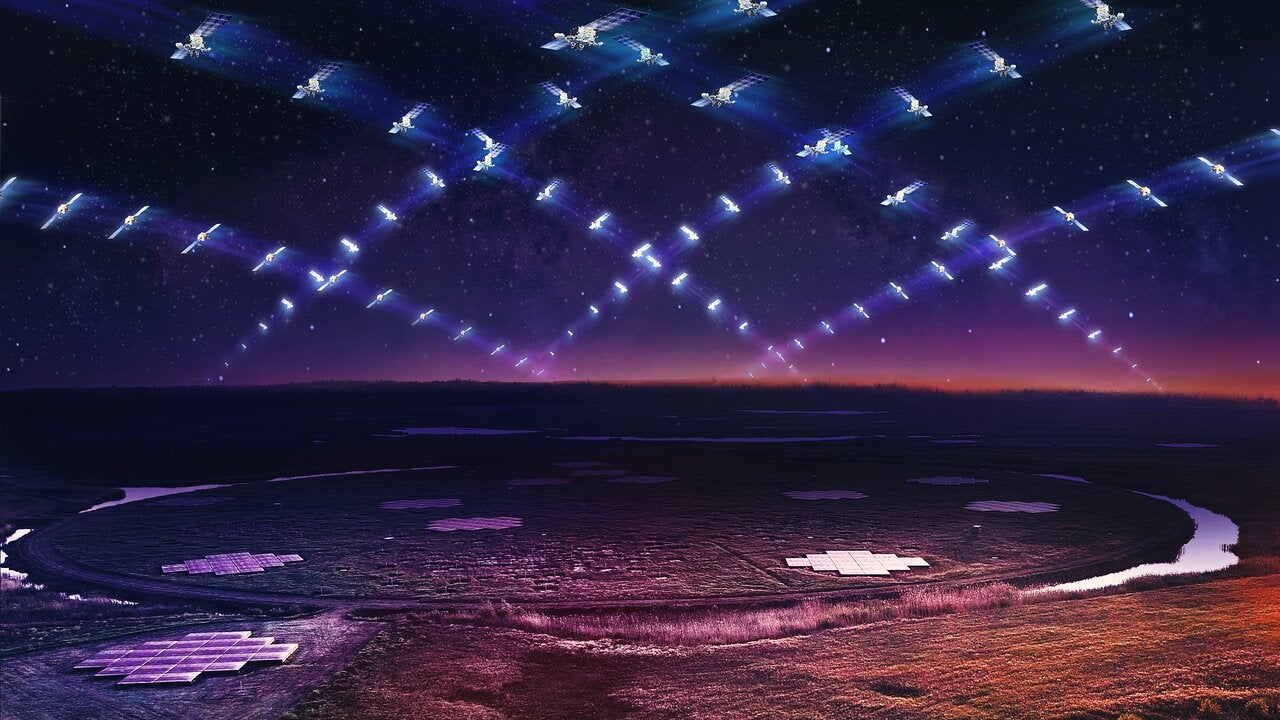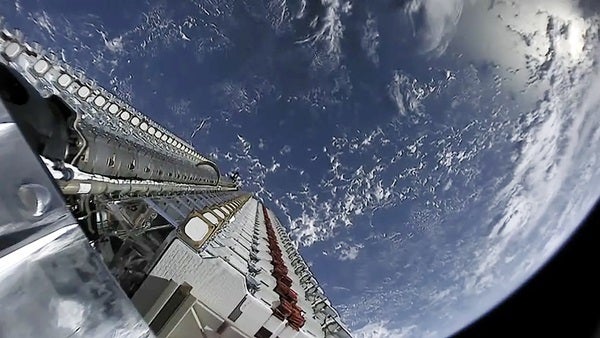
The vast fleet of Starlink satellites is interfering with astronomical observations, a study published in Astronomy and Astrophysics has revealed. When astrophysicists observed 68 of SpaceX’s satellites with the Low-Frequency Array (LOFAR) telescope in the northern Netherlands, they detected unintended electromagnetic radiation emanating from onboard electronics on the satellites.
As more large constellations of satellites are set for launch, the impact they will have on data collection and observations is now gaining attention from experts and being more carefully considered. “We need to be prepared and understand what can happen if these extremely large constellations are ever launched and [their] effects,” says spectrum manager at the Square Kilometre Array Observatory (SKAO) and study author Federico Di Vruno.
Di Vruno says that the vast number of planned satellites ranging in the hundreds of thousands may significantly interfere with radio astronomy. Starlink plans to eventually launch a total of 42,000 satellites. To date, more than 4,000 skim past the skies in low Earth orbit. More recently, on July 15, SpaceX’s Falcon 9 launched 54 Starlink satellites into space.
An invisible universe
Countless objects in space radiate different forms of light on the electromagnetic spectrum. Throughout space, electromagnetic waves travel like ripples moving through water. Distant galaxies, vibrant nebulae, and radio bursts from planets all emit forms of electromagnetic radiation that experts tune into with radio telescopes and amplify to get the full picture of what we can’t see with our eyes.
When astrophysicists observe the skies for these celestial phenomena, they do so at frequencies between 30 megahertz [MHz] and 300 gigahertz [GHz]. For example, scientists could pick up signals from a cell phone on the Moon at these sensitives.
Di Vruno explains that while the SpaceX satellites do emit electromagnetic radiation that may interfere with radio telescopes on Earth, he states that it is no more than that released from a television. What creates a big problem for astronomers is the total number of satellites that emit radiation simultaneously, which creates a disruptive amount of radiation.
Of the 68 satellites observed during the recent study, the team detected radiation between 110 and 188 MHz from 47 of Starlink satellites, according to a statement. This range encroaches on a protected band of 150.05 and 153 MHz, allocated by the International Telecommunications Union (ITU). However, SpaceX did not violate any rules protecting radio astronomy because currently no regulations are in place to protect terrestrial radio telescopes against radio interference.
The swarm of satellite constellations is a network of units that monitor Earth, provide communication, and ensure uninterrupted or near-uninterrupted global broadband Internet coverage. Other, larger constellations are also planned for launch, such as OneWeb. This global communications network currently has 648 satellites in 12 orbital planes situated in low-Earth orbit.

The leak
All satellites orbiting Earth produce and receive radio signals to and from Earth to communicate with the ground. Radio astronomers have dealt with this excess “noise” for decades. They can mitigate the impact these signals have on research by tracking where the satellites will be and avoiding their locations when seeing or noting any interference within data.
Earlier this year, SpaceX and the National Science Foundation finalized an agreement wherein they agreed to limit interference from the Starlink satellites to radio astronomy assets observing between 10.6 and 10.7 GHz, such as the National Radio Astronomy Observatory and the Green Bank Observatory. And while astrophysicists have worked around radio frequency interference, experts are concerned about the number of satellites that will leak radiation, making a higher percentage of their data unusable.
“If your stream has radio frequency interference, you just get noise,” says Yvette Cendes, a radio astronomer at the Harvard-Smithsonian Center for Astrophysics. “If you have an hour-long observation and you‘re left with only 10 minutes, it’s just a lost observation.”
Di Vruno describes it as being in a dark room when, suddenly, someone lights a torch near your eyes. “You are just suddenly blind, and you don’t see anything. That’s a similar situation.”
Collaborations
The study brings to light what must be considered now that large constellation array launches are becoming commonplace. Currently, the study’s authors are in contact with SpaceX, discussing possible ways to mitigate the leak of unintentional radiation. “We are getting to this early so we can have this discussion not only with the regulators to try to say, how can we address the lack of regulation here because we see that this is an important thing,” says Di Vruno.









